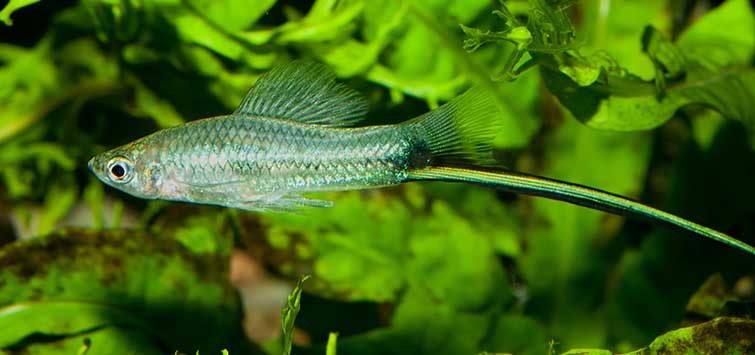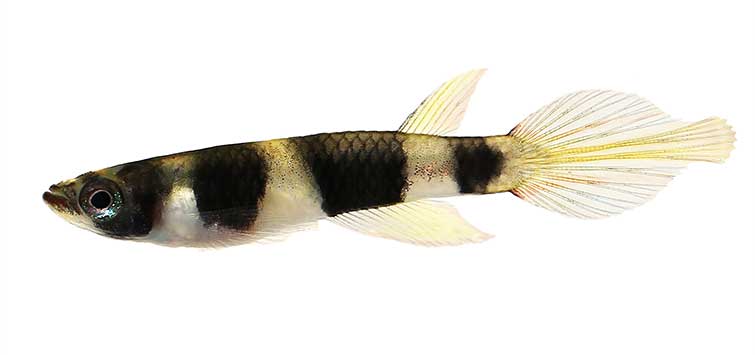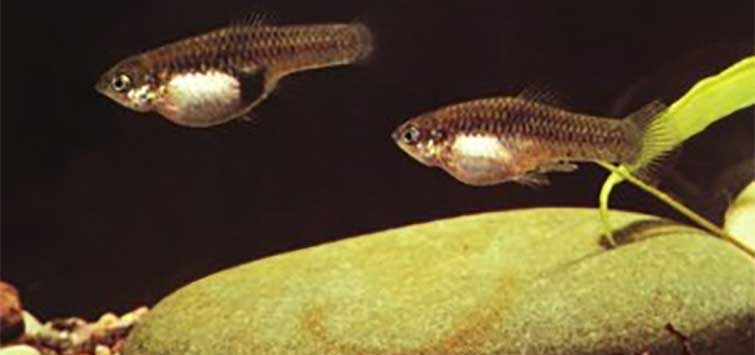Xiphophorus montezumae
Common Names: Montezuma sword, Monty
Type Locality: Rio Verde near Rascon, Mexico
Range: Northeastern Mexico
Taxonomic Troubles: None. This is the original designation.
Size: 8.5 cm (3.4 inches) female, 7.5 cm (3 inches) male, with sword up to 15 cm (6 inches)!
Preferred Water Chemistry: Tropical freshwater. Temperature 20 to 24.5 degrees Celsius (68 to 76 degrees Fahrenheit), pH 7.0 to 8.0, medium to very hard 150 to 350 ppm.
Difficulty: Hardy, but not as tolerant as its more domesticated cousins. Requires plenty of space, proper water conditions, and a good diet.
Tank Setup: A large aquarium with great filtration. Plants will afford cover for the fry.
Feeding: Will usually take any aquarium fare but should have quality live, frozen, or freeze-dried foods, as well as ample algae for grazing.
Breeding: Easy. Typical ovoviviparous paeciliids, these swordtails are reliable breeders when conditions are right.
Fish Description
Variable, with a greenish base and various spots, blotches, or lines, and horizontal iridescent green stripes. The male's sword (an extension of the lower caudal rays) is yellow, edged boldly in black, and is commonly twice the length of his body. The male's dorsal is large and sail-like. A form call "ivory" with a lighter background and increased dark splotching, is also established in the hobby.
Notes
This is one of the most impressive wild swordtails. The courting display is dynamic--even acrobatic--with the male brandishing his opulent sword in rapid backward lunges and angled parries, all the while displaying a fully spread dorsal fin. Males are typically intolerant of each other, but in a sufficiently large setup with plenty of females, two males may be kept busy enough to limit their interactions merely to boisterous displays.
Not common in retail stores, this species is well entrenched in the specialty hobby and is readily available from aquarist breeders. As with all wild species, these fish should be maintained in tanks containing no fishes of different species that are int he same genus, to prevent hybridization.
Scientific studies have shown that the eponymous sword of many male Xiphophorus species is a trait preferred by females. In fact, females of some Xiophophorus species whose males lack swords show a preference for males with swords, a sexual selection that reaches its pinnacle in X. montezumae. This feature is costly for the males, making the female's preference one of selecting the fittest males. Wild swordtails, while lacking the primary colors of many domesticated strains, have a subtle beauty of reticulation, iridescence, and patterning, and this species is no exception.
With the addition of the exceptionally long sword of the male, this fish makes a grand showpiece, and it can demonstrate to an aquarist the glory of these livebearers before commercial breeders got a hold of them.

.png?h=595&iar=0&w=2781&hash=5FD5E69473BCC22199FBFA2FB71B6033)



